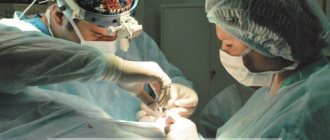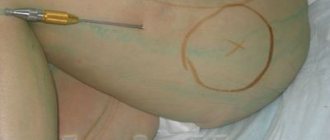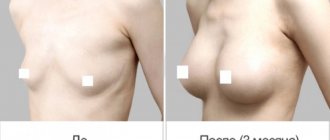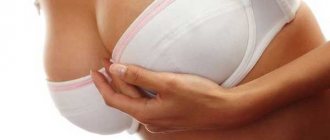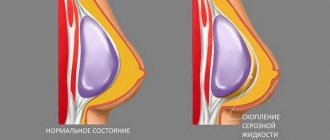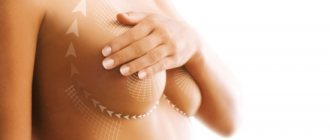Aesthetic breast surgery is one of the most common plastic surgeries. About 700,000-800,000 operations are performed annually in the world.
These include augmentation, reduction, lifting, as well as combined operations.
Women's breasts begin to undergo changes from puberty, and this process continues throughout life.
These changes are cyclical, and they are also observed with changes in body weight, during pregnancy, during and after breastfeeding, and also occur with age. Changes can lead to hypertrophy, postpartum involution, ptosis (with or without stretch marks).
Changes/deterioration in breast shape greatly affect a woman’s self-esteem. For this reason, many women decide to undergo breast surgery in order to regain their former shape or improve theirs.
Drooping breasts (mastoptosis)
Sagging breasts (sagging breasts) are called mastoptosis. It occurs for the reason that the ligaments that hold the adipose tissue of the glands become flaccid, while the amount of this very adipose tissue often increases with age for many reasons.
In addition, due to the slowdown in the synthesis of collagen and elastin, the skin gradually loses its elasticity and stretches excessively.
It is commonly believed that factors such as breastfeeding, not wearing a bra, or heredity accelerate breast sagging, although in reality each of these is a misconception.
Based on the results of a long-term study by doctors, it was found that after carrying a child, the shape of the breast becomes worse, and this is not affected by breastfeeding.
During pregnancy, changes in breast tissue provoke hormonal fluctuations, the gain of extra pounds and the volume of adipose tissue.
As for heredity, it’s time for the fair sex to stop being confident that their breasts will suffer the same fate as the mammary glands of their mother or grandmother.
In fact, in only 5 out of a hundred women they practically do not change throughout their lives, while in the rest they undergo a noticeable individual transformation in each case.
Only the following indicators depend on genetic factors:
- percentage of adipose and glandular tissue;
- collagen and elastin levels;
- the degree of age-related decrease in weight and volume of glandular tissue.
The effect of underwear and sports on the chest
Refusal of underwear as a cause of mastoptosis has not been fully confirmed. Moreover, studies have been conducted more than once (by American and then Japanese scientists) during which the tested volunteers did not wear a bra for a long time (even while playing sports).
The experiment showed the following:
- underwear only changes the shape of the mammary glands, but from an anatomical, medical or physiological point of view it does not bring any benefit;
- thanks to sports training without underwear, the breasts become more elastic, their shape improves, and the distance between the nipple and collarbone is reduced;
- refusal to artificially shape the mammary glands for a period of more than 2 years reduces the risk of developing sagging, since the ligaments retain natural contractility and the condition of the skin improves.
On the contrary, reasons such as smoking or weight fluctuations should not be considered myths. Tobacco smoking is dangerous because it negatively affects the synthesis of elastin, along with collagen, which is responsible for the skin’s ability to contract after stretching.
Gaining a large number of kilograms and losing a lot of weight (just one, but significant one is enough) can lead to sagging.
When a woman rapidly gains weight, the skin of her breasts becomes very stretched and cannot cope with the load, as with a sudden weight loss - the stretched skin simply does not have time to adapt to new circumstances and sag.
Nothing harms the shape of the mammary glands more than weight swings, that is, constant changes in body weight, which are typical for those who experiment with diets and either lose weight or gain weight.
Therefore, you should always try to stay in approximately the same weight category, and if you lose weight, then only under the supervision of a doctor. Otherwise, not only the beauty of the breasts will suffer, but also the health of various organs.
Exercising is very good for health, but it is bad for large mammary glands if there is no support for them while running or jumping.
After all, breasts without underwear describe crazy trajectories in three planes, which provokes serious stretching of the skin. For this purpose, special sports underwear has been developed that reduces the mobility of the mammary glands during intense training.
Indications and contraindications for mastopexy
It is believed that the most noticeable changes occur in the breasts due to pregnancy and subsequent breastfeeding. During this period, the mammary glands, under the influence of hormones, enlarge, and the skin over them stretches. After lactation is completed, the glandular tissue returns to its original state, and sometimes becomes even smaller, while the stretched skin simply sags. In addition to the hormonal influences associated with childbirth, the appearance and firmness of the breasts are influenced by many more factors, as discussed above.
Surgeons consider the following indications for mastopexy:
- Sagging breasts, which have normal or insufficient volume, and if the skin is changed, it is only slightly;
- A gland that is normal in volume, but with highly stretched skin that has lost its elasticity;
- Ptosis with stretched skin and insufficient breast volume;
- The presence of stretch marks on the skin;
- Asymmetry of the mammary glands.
A woman can independently determine the presence or absence of breast ptosis by placing her palm in the skin fold under the organ. If the gland covers two fingers, then we can talk about the initial degree of ptosis, 4 fingers - about moderate, with severe ptosis, the chest will cover the entire palm. It is clear that you should definitely take into account the initial volume of the mammary gland, and if it is impressive, then you will still have to focus on the location of the nipple, and not on the palm.
Ideally, surgery should be performed when breast volume is normal and ptosis is moderate. If you have a normal bust size, a breast lift without implants is indicated. If to correct the shape of an organ it is necessary to enlarge it slightly, the surgeon will supplement the operation with endoprosthetics. In case of glandular ptosis, soft tissues in the lower segment of the chest are removed, followed by mandatory fixation of the breast to the chest wall. In the case where the breasts are large and the woman does not mind having them reduced, a lift will be carried out together with reduction plastic surgery.
breast lift with endoprosthetics
Breast lift has its contraindications , which the surgeon will definitely find out when planning the operation. Mastopexy is not performed if:
- Acute general infections (until complete recovery);
- The presence of scar changes in the mammary glands;
- Mastopathy, cysts and other focal changes in the breast;
- Severe diseases of internal organs;
- Blood clotting disorders;
- Diabetes mellitus;
- Oncopathology;
- Mental illnesses;
- Pregnancy and ongoing lactation, or if less than a year has passed since the cessation of feeding;
- Pustular skin lesions, eczema at the incision site.
Degrees of mastoptosis
To determine how much the skin and ligaments supporting the breast have stretched, the location of the nipple relative to the fold of skin under the glands is used as a guide. This refers to the area where the chest touches the body.
There is a special scale that helps determine the degree of mastoptosis: the first is slight sagging, when the nipple is at the same level as the breast fold, but above the entire volume of the gland.
Further, according to the stage of descent of the nipple and the volume of the gland below the described fold, medium, developed and severe ptosis is determined (the nipple is directed towards the floor).
There is also pseudoptosis, when the tissues have dropped down, and the nipple remains at the level or even above the breast fold, and parenchymal disproportion: there is no necessary fullness of the glands and the nipple practically lies on the fold of skin under the breast.
Many plastic surgeons talk about ideal proportions. There are relative standards: approximately 45% of the breast should be located above the nipple, and the remaining 55% should be the lower part of the breast (from the nipple to the fold).
Plastic surgeon Umbarin Mahmoud
Breast lift methods
Currently, a facelift is a very popular procedure, so today there are many ways to meet the demand.
In addition, plastic surgery and other manipulations are carried out so that the lactation function and the woman’s ability to feed her baby with breast milk are not disrupted.
Very often it is necessary to combine a lift with other interventions. For example, implants can be immediately introduced to obtain the best result.
Plastic surgeon Daniel Barrett
Existing methods of breast correction and returning it to its previous appearance are divided into surgical and non-surgical methods. They all have their own characteristics.
Today it is not necessary to make radical changes, since you can do without implants; reviews from people indicate the effectiveness of methods without surgery.
Mastopexy
Mastopexy belongs to the category of surgical methods for getting rid of mastoptosis. It can be classic (dermal) and is an operation to remove excess skin from the mammary glands. Depending on where the cuts are made, the following types are distinguished:
- Periareolar. The skin around the nipple is cut.
- Vertical. A vertical incision is made from the nipple to the fold of the gland.
- Anchor. The pattern of the cuts resembles the outline of an anchor.
In addition to the classic types of surgical lifting, new ones have appeared and are developing relatively recently: endoscopic, reduction and augmentation mastopexy, as well as combined operations.
Endoscopic mastopexy has the following features:
- It is carried out without incisions, all manipulations are carried out through punctures of the skin. This technique is ideal for those who do not accept the presence of postoperative scars.
- This type of operation is usually combined with a reduction of the mammary glands (both fatty and glandular tissues are partially removed) or their enlargement through the installation of implants.
Remember that a lift corrects the shape of the breast, but does not enlarge it.
Plastic surgeon Curtis Perry
Reduction mastopexy involves the immediate removal of skin and soft tissue. The operation is performed only in cases where breastfeeding is not planned in the future, since the ducts of the gland are injured during the operation.
Augmentation mastopexy is a combination of breast lift and breast augmentation. First, a mastopexy is performed, and then the implants are installed.
The method assumes that both stages are carried out simultaneously, but, nevertheless, quite often these operations are carried out with a time difference of 4 - 6 months.
Combined operations - performing an extended list of plastic surgeries, including mastopexy, changing the size of the glands and correcting their shape.
History of vertical mastopexy
Today, there are a number of techniques for correcting ptosis. The choice of technique depends on the initial data, experience and preferences of the plastic surgeon.
Historically, the first recorded mastopexy was performed by the French surgeon Pousson.
The first mastopexy, which involved moving the nipple-areolar complex to a higher position and removing excess skin in the lower pole, was described by Lotsch in 1923.
In the techniques described in the first half of the 20th century, no attention was paid to the number of scars and their location, the vascular supply of the feeding pedicle and, most importantly, the aesthetic appearance of the final result. The result was frequent formation of necrosis of the nipple-areolar complex, and ultimately an unacceptable aesthetic result.
In the second half of the twentieth century, there was an improvement in techniques. Pitanguy, Strombeck and Skoog made mastopexy a safe procedure using Wise markings.
Goulin was the first to develop vertical mastopexy, and this technique was later improved by Lassus and popularized by Marczak and Lejour.
At the same time, the approach to the formation of the stem was changed to ensure the safety of the nipple-areolar complex. Medial, lateral, superior, inferior, and combined feeding pedicles have been described.
Various stem orientations have been developed to provide increased safety of the nipple-areolar complex. Mastopexy with vertical scar is now one of such operations in which the safety of the nipple-areolar complex is of paramount importance.
Vertical mastopexy ensures adequate removal of excess skin along with the required amount of glandular tissue.
Preparing for surgery
If a woman decides to undergo a surgical breast lift, she must prepare for this, since the doctor will not be able to perform the operation instantly without additional preparation.
In addition, it is initially necessary to undergo the prescribed tests so that the surgeon can assess the patient’s health, the condition of the mammary glands, and exclude contraindications.
If there are no obstacles to a breast lift, then you can begin to prepare for surgery. 2-3 weeks before this you need to:
- Forget about smoked and fried foods. Also, do not eat too fatty foods.
- Quit nicotine and other bad habits. This is due to the fact that smoking patients are at risk of developing blood clots.
- Inform the doctor at the first consultation about taking specific medications. Perhaps they are contraindicated.
- Prepare the necessary things for the clinic. These could be documents, hygiene products, etc.
- Don't overload your body. A week before the planned breast lift, you need to stop physical activity altogether.
- The day before the intervention, it is recommended to stop eating solid foods.
Preparation for breast lift and technique of its implementation
Preparation for breast lift surgery includes a set of examinations and visits to specialists to exclude possible contraindications. Appointed:
- Blood and urine tests;
- Blood clotting study;
- Tests for HIV, hepatitis, syphilis;
- Determination of blood group and Rh factor;
- Fluorography;
- Ultrasound of the mammary glands or mammography;
- Electrocardiography.
A woman should also visit a gynecologist, and, if indicated, a cardiologist or endocrinologist. No later than two weeks before breast lift surgery, blood-thinning and hormonal medications are discontinued, vitamin E is stopped. If a woman smokes, then this habit should also be given up in advance, since smoking sharply reduces the regenerative potential of tissues, contributes to circulatory problems and provokes serious complications.
Before a breast lift, the surgeon will find out in detail the patient’s expectations from the operation and correlate them with the real possibilities of surgery. Many clinics offer computer simulation of the planned result of mastopexy to make expectations and the result as close as possible. Before the operation, markings are applied to the woman’s body in a sitting or standing position to serve as a guide for the incisions.
On the eve of plastic surgery, the patient comes to the clinic with all the test results, talks with the surgeon and anesthesiologist, does not eat or drink anything in the evening, takes a shower and changes clothes. It is important to calm down and relax. Breast lift surgery is performed only under general anesthesia and takes about 2-3 hours. It is preferable to carry it out in the middle of the menstrual cycle.
There are several ways to perform a breast lift:
- Vertical mastopexy;
- Periareolar technique;
- Mastopexy with implantation.
types of mastopexy
Mastopexy is carried out in several stages:
- Treatment of skin with antiseptics;
- Carrying out cuts along planned lines;
- Removing excess skin, moving the nipples upward;
- Applying a cosmetic suture, treating with an antiseptic, covering the wounds with sterile napkins;
- If necessary, install small drains to facilitate the outflow of contents from the wound.
Methods of mastopexy differ in the location and size of the incisions and the features of fixation of the gland to the chest wall. During the operation, the surgeon is guided by the lines that were drawn on the woman’s body in advance. To lift the breast to its normal position, a gland is released, which will then be fixed to the chest wall, while excess skin and fat are excised. Additionally, breast implants can be implanted.
With the initial degree of ptosis of the mammary gland and small breast size, one of the most gentle operations is performed - periareolar mastopexy . With this plastic surgery, the incision is made semilunarly above the areola or circularly (circular mastopexy) along the border of the areola and non-pigmented skin around the nipple. Excess skin is removed, a cosmetic suture is placed on the edges of the wound, and the chest is raised.
Circular mastopexy , when the incision goes around the areola, is most effective in patients with initial ptosis and a small area of excess skin. It allows not only to raise the nipple, but also to change the diameter of the pigmented isola and correct slight asymmetry.
circular mastopexy
For more severe mastoptosis, the surgeon may recommend vertical mastopexy . The essence of the operation is to make several incisions - around the nipple along the areola line and vertically downwards. After removing excess skin, the edges of the wound are brought closer together and cosmetic sutures are applied.
Starting from the second degree, ptosis is treated by vertical and anchor lifting. With a vertical lift, the incision goes along the areola line and then vertically downwards, and with an anchor lift, the described incisions are supplemented by a third, which is located under the mammary gland. These types of mastopexy are more traumatic and leave more scars, however, in cases of severe breast ptosis, a positive result can only be obtained with their help.
anchor breast lift
Separately, it is worth dwelling on a breast lift using mesothreads. This method is positioned as non-surgical and safe, but in addition to these advantages, it also has some disadvantages. Mesothreads can be used in women with slight sagging breasts of small size, otherwise they will have no effect.
Implantation of mesothreads into the mammary gland is carried out under local anesthesia, and this is an undoubted advantage of the method. The operation itself is much simpler than classic surgical mastopexy, but it must still be performed by an experienced and competent surgeon.
Mesothreads are a biocompatible polymer material that is used to tighten breast skin. Having strengthened the soft tissues, the threads dissolve on their own, and the effect of the procedure lasts for about two years. In one procedure, up to 10 threads can be introduced, each of which is about 6 cm long.
3D mesothreads
Mesothreads can have spikes, resemble a spring or a pigtail. Biodegradable and non-absorbable threads are used. Polypropylene non-absorbable mesothreads retain the tightening effect for up to five years and are used in women after 40 years. Modern surgeons use third-generation 3D mesothreads for mastopexy - with spikes oriented in one or several directions. These threads achieve good tissue fixation.
The surgeon uses special needles to insert threads into the soft tissue of the breast. The skin is numbed with local anesthetic cream. The threads are inserted in such a way as to provide maximum tightening; they can be secured to the collarbone.
The introduced inert material does not cause allergies, but enhances the formation of collagen, which strengthens and tightens tissues. Over the course of a year after surgery, the threads dissolve, but the collagen frame remains, providing breast lift. The effect lasts for about two years.
The result of mastopexy with mesothreads is very difficult to predict in advance, since it depends on many circumstances: the volume of the patient’s breasts, the severity of ptosis, skin condition, type of mesothreads, and the quality of the procedure. The best result will be after a few months, but over time it will gradually disappear.
It happens that after implantation of threads there is no visible effect at all, so disputes regarding the advisability of treating ptosis with them do not stop. It is important that a woman does not place excessive demands on the method, otherwise the expectations will be very different from the result. By the way, many experts believe that the method is good not so much for eliminating ptosis, but as a preventive measure, including after breast surgery.
Rehabilitation period
When the doctor is convinced that no complications have arisen, he then discharges the patient. After a breast lift, the suture may come apart, necrosis of the skin, large bruises, etc. may appear. You should not be afraid of these terrible words, since in general the operation takes place without complications.
But after the intervention, you need to set yourself up for a long recovery period, which lasts 1-6 months.
There are such features of recovery after a facelift:
- To reduce post-operative scars, it is recommended to undergo various physical procedures. They are indicated immediately after the doctor removes the drainage tubes.
- You may need to take painkillers for 7 to 10 days to reduce pain after the intervention.
- It is worth limiting yourself from physical activity for a month, as the skin needs to recover.
Scars remain after a breast lift. Over time, they lighten and are almost invisible. But scars can be eliminated with laser.
It usually takes about 1-2 years for the scars to become almost invisible.
Plastic surgeon Frank Fechner
Preventing sagging
How to prevent breast sagging? There are special essential oils for breast tightening. They are concentrated liquids that can relieve stress from the skin and glands and increase their elasticity. For these purposes, essential oil complexes are used:
- Complex for increasing skin elasticity. Mix 10 drops of jojoba oil, 4 drops of fennel oil, 2 drops of hop oil and 10 drops of hazel oil.
- Non-surgical breast lift. Take 30 ml of base oil and add 7 drops of fennel oil, 5 drops of anise oil and 3 drops of rosemary oil.
- For aging skin. Take 20 ml of jojoba oil and 10 ml of avocado oil, add 4-5 drops of geranium, dill, cypress and sage oils to the mixture.
Essential oil mixtures should be rubbed into the skin of the mammary gland with massage movements in the morning and evening. How to tighten large breasts? The effect will also be for large breasts if you take a bath with added oils 2 times a week.
After childbirth
What kind of breast correction can be done after childbirth? For example, you can use masks to tighten the skin of the mammary glands:
- Cabbage mask. Mix cabbage in a blender with 7-10 drops of castor oil. Apply the mask to the skin of the mammary glands, avoiding the nipple area. Leave for 15 minutes, and then remove the remaining mixture with a napkin.
- Blue clay mask. Dilute the prepared clay package with calendula decoction, add 5 drops of myrrh and apply to the mammary gland area. Wash off after complete drying.
- Oatmeal mask with honey. Take half a glass of oatmeal and steam with hot water. After 30 minutes, add 3 teaspoons of honey. Apply to the mammary gland for 15 minutes and rinse with water.
From this article we learned how to lift sagging breasts, what methods exist to restore their elasticity surgically and at home.
Non-surgical methods
Not all girls and women will dare to go under the scalpel. But what to do if you want to tighten your breasts and improve their appearance?
In this case, you should pay attention to breast lift without implants; before and after photos confirm the effectiveness of some non-surgical methods.
There is more than one similar method. Breast lift without surgery and without installing implants is carried out in the following ways:
- Lipofilling. It involves restoring or increasing the volume of the mammary glands due to the injection of their own adipose tissue extracted during liposuction. This method of breast lift is recommended for small breasts and only emerging ptosis. However, lipofilling cannot guarantee a lasting result, since part of the injected fat may gradually resolve.
- Thread lift. Changing the shape of sagging breasts using threads is possible only in cases where sagging is at the initial stage and the mammary glands are small. Most often, threads are recommended as a means of preventing tissue sagging and skin stretching.
- Correction with filler. Macroline is so far the only certified filler used for breast lift. The basis of the drug is hyaluronic acid, but, unlike facial fillers, Macroline has greater density and viscosity, and its molecules are much larger. Therefore, it perfectly creates volume and dissolves much more slowly. Another advantage of hyaluron is its ability to produce a rejuvenating effect, due to which, in addition to breast lift, rejuvenation of the skin of the neck and décolleté occurs.
- Myostimulation. During this procedure, muscles are trained using electric current. But to get a positive result, you will have to conduct more than one session. You need to understand that a colossal effect cannot be achieved with the help of myostimulation.
- Microcurrents. This method is similar to the previous non-surgical breast lift. The cosmetologist acts on the skin with microcurrents, using various serums, as a result, the skin improves, the muscles strengthen, so the breasts are visually tightened.
- Laser tightening. This procedure is gaining increasing popularity. It passes without pain, and scars do not form after it. Laser pulses stimulate the glands, resulting in a slight lifting effect.
You should not hope for the possibility of performing a thread lift for breasts larger than size 2, since under the weight of the glands the threads will stretch and cut through the soft tissue.
The composition of threads for lifting can vary: non-absorbable gold and platinum or absorbable polylactic acid. The latter are used mainly for preventive tightening.
It is not possible to radically change your breasts through non-surgical methods. Sometimes, with severe sagging, surgery is the only option.
Plastic surgeon Manshi Shah
All about breast lift
If a woman at Balzac's age has high and firm breasts, one can only envy her. In her case, nature practically accomplished a feat by preserving the beauty of one of the most important parts of the female body. Unfortunately, this is such a rare exception to the rule that you will hardly find among your friends at least one lady who, say, by the age of 50, can boast of an elastic bust.
Throughout life, a woman's breasts undergo changes in volume and shape. This may be due to hormonal changes, fluctuations in body weight, and decreased skin elasticity. Most often these parameters change after pregnancy and breastfeeding, although problems can begin to appear even at a young age.
In this case, prolapse of the mammary glands almost always occurs, which significantly worsens the appearance of the breasts and often leads to a certain psychological discomfort. The appearance of the mammary glands is determined by the condition of the skin, the volume of subcutaneous tissue and glandular tissue, therefore no amount of physical exercise or cosmetic products can affect their shape.
But, of course, there is no need to despair. Because plastic surgery of the mammary gland has been existing and successfully developing for many decades, in particular such a direction as mastopexy. It is a type of mammoplasty in which the breast is given an aesthetic shape.
The operation can change the height of the bust, change its contours and size, as well as remove excess skin and excess fatty tissue. For example, the winner of the Oscar for Best Actress in the film The Watch, one of the brightest stars of world cinema, Nicole Kidman, went through all this. Or another, no less stellar example is the singer and composer Madonna. Finally, the famous TV presenter Dana Borisova turned to plastic surgeons for mastopexy.
The list can be continued for a very long time, because this problem is no less relevant and widespread than insufficient breast size, and often they are combined. In these cases, you have to solve two issues at once - restoring the shape and achieving the desired size. Only an integrated approach can make a woman’s breasts beautiful and achieve the most aesthetic result.
Who needs a breast lift?
The surgeon’s tactics for surgical correction of unsatisfactory breast shape depend on a combination of many factors. First of all, it is the shape and volume of the breast. In a bust without signs of ptosis, the areola is located above the line of the submammary (inframammary) fold. But if the nipples are lower, these are already signs of mastoptosis (or simply ptosis).
There are three degrees of ptosis:
- 1st degree (mild ptosis) – changes in the breast are minimal, the nipple is lowered to the level of the lower fold of the breast;
- 2nd degree (moderate ptosis) – the nipples are lowered below the specified line, but they maintain a horizontal position, that is, directed forward;
- 3rd degree (severe ptosis) - the mammary glands look flat, significantly drooping, nipples point down.
In addition, ptosis is often combined with various types of asymmetry of the mammary glands: in volume, height of the inframammary fold, diameter of the areolas, etc. The original size is also of fundamental importance. Taken together, all these indicators will determine the surgeon’s tactics when choosing a correction option.
The first breast lift techniques were developed approximately 100 years ago. But first things first. To date, there are many options for mastopexy. Exactly 40 years ago, two foreign plastic surgeons, Letterman and Sharter, tried to summarize all the methods known to them by that time. There were four main groups:
- Breast lift using skin changes only. During this operation, the mammary glands remain intact, only excess skin is removed.
- A lift is performed by attaching breast tissue to the anterior chest wall. This refers, of course, to its upper layers - skin and muscles.
- The mammary glands are modified by suturing the glandular tissue, the same one that in the female breast is responsible for the production of milk necessary for feeding the baby.
- Ptosis is eliminated by breast augmentation using prostheses - implants.
For the first time, the French surgeon S. Girard came up with the idea of attaching upwardly displaced mammary gland tissue to the chest in 1910. This method has become fundamental to most modern mastopexy operations. 13 years later, another method was invented: remove excess skin from the lower part of the breast, and move the nipple and areola to the top.
After another quarter of a century, plastic surgery invented a third method. Improve the breast by moving up the flap, which is located in the lower sector of the breast, and fixing it to the anterior wall of the chest. Subsequently, doctors focused their attention on inventing methods that would improve the female bust without leaving noticeable scars on it. These discoveries were made from 1961 to 1974.
Back in 1966, a new word was said in breast lift: it was said by the French surgeon P. Regno. He proposed correcting grades 1 and 2 ptosis by implanting endoprostheses.
Operation stages
Depending on the severity of ptosis and deformation of the mammary glands, the scope of the mastopexy operation can vary significantly.
If ptosis is mild and is caused by a decrease in the volume of glandular tissue, without excess stretched skin, then breast replacement using implants with a high projection profile may be sufficient to achieve an aesthetic result.
If there is a larger volume of stretched skin, it is necessary to remove them to give the gland harmonious proportions. If the volume of the gland is sufficient, then its shape is corrected using special sutures, and then plastic surgery of the skin tissue is performed.
If the volume of glandular tissue is insufficient, any version of mastopexy is complemented by endoprosthetics of the mammary glands.
Operation methods
Currently, three types of mastopexy are most commonly used.
1. Periareolar mastopexy.
It is performed when ptosis of the mammary glands or their asymmetry is caused by the presence of moderately expressed excess skin. With this type of lift, two circular incisions are made. One of them is around the circumference of the areola (which allows you to adjust its shape and size if necessary). The second, larger in diameter, is around the first. Excess skin between them is removed, then intradermal sutures are placed between these areas. The postoperative scar is located around the circumference of the areola.
2. Mastopexy with vertical suture.
If there is severe ptosis of the mammary glands, performing periareolar mastopexy does not adequately solve the problems. Removal of extended areas of skin between two circular incisions in this case will lead to significant gathering of the outer edge and significant flattening of the mammary gland.
The appearance of the breast after such an operation will be far from natural proportions. To give the breast a natural teardrop shape in such cases, it is necessary to supplement the periareolar incisions with vertical ones to remove excess skin in the lower sections.
3. Mastopexy with a T-shaped (“anchor”) suture.
With extreme degrees of ptosis of the mammary glands, a horizontal inframammary incision is also required. The additional postoperative suture is located in the submammary fold and does not have a significant effect on the cosmetic result of the operation.
Of course, when planning an operation, preference is given to mastopexy options, after which the number of postoperative scars is minimal. However, in cases of severe ptosis of the mammary glands, when objective initial data require adequate correction, an unreasonable desire to minimize the amount of intervention can lead to unsatisfactory aesthetic results.
Preparing for surgery
Since mastopexy is a serious and fairly lengthy surgical procedure, it is necessary to undergo a full course of preoperative examination to exclude the possibility of adverse consequences due to any health problems. It is required to inform the surgeon in advance about all existing or previously suffered chronic diseases, the presence of drug intolerance (allergies to drugs), and bad habits.
Smoking patients should pay special attention to the fact that for a favorable course of the postoperative period and wound healing, it is advisable to quit smoking for two weeks before surgery and for a month after it.
It is advisable to perform mastopexy surgery no less than six months after completion of breastfeeding (lactation).
If you plan to reduce your weight through diet or special physical activity, mastopexy should be performed after achieving the desired result. Otherwise, sudden weight loss after surgery may worsen the aesthetic result.
Contraindications to such operations are: bleeding disorders, diabetes mellitus, infectious, severe autoimmune, oncological diseases, as well as diseases of the cardiovascular and respiratory systems, which are risk factors for general anesthesia.
If there are no contraindications, then the next step will be an examination. After all, the patient may not be aware of possible existing health problems. It is necessary to perform laboratory tests of urine and blood (clinical and biochemical, determination of group and Rh factor, coagulogram (clotting test), tests for HIV, syphilis, hepatitis B and C), electrocardiogram, fluorography, ultrasound of the mammary glands.
A week before surgery, you need to stop taking medications that affect blood clotting. On the day of surgery, you should not eat or drink anything.
Depending on the degree of complexity, the operation can take from 1 to 2.5 hours. Already in the evening on the day of surgery, patients can get up and eat. The length of hospital stay is usually one day.
Rehabilitation after surgery
Postoperative pain may occur for 1-3 days. After this period, their intensity decreases significantly, and taking tablet analgesics is sufficient.
For a month after surgery, you must wear special compression garments. When mastopexy is combined with breast augmentation, this is necessary to fix the breast implants in the correct position. In addition, wearing compression garments allows you to reduce the load on postoperative sutures, which significantly reduces discomfort and creates conditions for rapid healing of the postoperative wound and the formation of a cosmetic scar.
After discharge from the hospital, you will need to take medications recommended by your doctor. To prevent postoperative complications, antibiotic tablets are prescribed for 7 days. To eliminate possible pain, it is recommended to take analgesics.
For a week after surgery, you should not wet the area of the postoperative wound.
7-10 days after the operation, after the surgeon has assessed the condition of the postoperative suture, you will be able to shower.
It is necessary to avoid physical activity for a month after the operation and intense activity for another two months. After this period, you can return to your normal lifestyle.
It is recommended to refrain from visiting baths and saunas for six months. During the year after surgery, it is necessary to avoid direct sunlight on the area of the postoperative suture (topless tanning), which threatens the occurrence of hyperpigmentation of scars in this area.
Depending on the severity of prolapse (ptosis) of the mammary glands, postoperative scars after mastopexy may have different extent and location. One of them is always located around the circumference of the areola. With severe ptosis, when periareolar mastopexy is not enough to correct it, the postoperative scar may have a vertical component, and, if necessary, also a horizontal one, located in the inframammary fold.
As a rule, the scar located around the areola, due to the fact that it is located on the border of the pigmented and unpainted areas of the skin, is less noticeable than in other areas. Due to its localization, a scar in the inframammary fold also does not worsen the cosmetic effect of the operation.
The vertical scar is most noticeable during the first months after surgery. However, after an average of 6 months, it, like all other scars, begins to fade, acquires a natural color, becomes thinner, more elastic and becomes comparable to the surface of the surrounding skin.
When performing these interventions, modern suture materials of the latest generation are used. Cosmetic absorbable intradermal sutures are applied, which do not require removal in the postoperative period.
To form a minimally noticeable scar and achieve the most aesthetic result in the postoperative period, it is advisable to wear a special silicone patch.
We will also name possible complications after mastopexy. This:
- infectious complications;
- hematomas;
- asymmetric scarring;
- decreased nipple sensitivity.
Such cases are, of course, very rare. As for nipple sensitivity, it usually returns to its original level within a period of 6 weeks to six months.
The final result of this surgical intervention will not be visible immediately. Moreover, at the beginning, especially after a T-shape lift, the breasts do not look entirely natural, with an overfilled upper pole and insufficiently voluminous lower ones. This is a temporary phenomenon. Over the course of several months, the bust takes on a natural teardrop shape. And when the postoperative sutures become minimally noticeable, patients will be able to appreciate the dramatic changes in their newfound breasts that have become possible thanks to this rather complex, but very effective operation.
Scientific editor: plastic surgeon V.S. Bakov
Question answer
Much. Typically the nipple will move above breast level. You can also increase your bust using implants.
Pregnancy affects the appearance of your breasts. Therefore, if you want to restore your results, you may need to have another surgery. This is why many doctors advise postponing mastopexy if you are planning to become pregnant.
It is impossible to know exactly what changes may occur, but in most cases a woman is able to breastfeed after this intervention. However, be sure to discuss all the details with your doctor.
Anesthesia
Breast lift operations and procedures differ not only in the extent of tissue injury and recovery time, but also in the methods of pain relief: general anesthesia or local anesthesia.
Anesthesia before breast correction can be performed in one of the following ways:
- intravenously;
- by inhalation;
- combination of sedation and local anesthesia;
- local anesthesia.
Rehabilitation
The effects of a breast lift are usually noticeable immediately after surgery. As a rule, nipple sensitivity does not decrease. However, if it has decreased, it may take up to 3 months for it to fully recover. A high-quality mastopexy ensures that the scars are less noticeable; they gradually become thinner and fade.
After the operation, you will need to spend about a day in the hospital. During the first week, you must visit the medical center every day to change dressings and monitor the recovery of the body. From the second week, you can return to your normal rhythm of life with minor temporary restrictions on physical activity and types of recreation.
*The operation is performed at a third-party medical center.
Side effects and complications
When deciding to have a breast lift, a woman runs the risk of encountering the following side effects:
- short lifting effect or lack thereof;
- eruption and migration of threads to the surface of the skin;
- sagging soft tissues;
- infection and inflammatory processes;
- swelling, allergic reaction;
- rejection of implants, injected drugs and threads;
- bleeding, suppuration, suture dehiscence, scars and cicatrices, asymmetry of the mammary glands;
- impaired sensitivity of the nipple and skin.
To understand what results you can expect from a facelift, it is recommended to look at the “before” and “after” photos.
Studies show that breast lift is a safe operation, since the mortality rate is very low (about 2.37%). Unpleasant consequences or death usually occur when a doctor sees them, so choose a specialist carefully.
Plastic surgeon Naveen Singh
Marking and operation vertical mastopexy
Marking is carried out with the patient standing with her arms down. A mid-vertical line is drawn from the interjugular notch to the xiphoid process, the inframammary fold is marked, and then the second vertical line, the mid-clavicular one.
The position of the new nipple-areolar complex is built around the P point (nipple position). The apex of the neo-nipple-areolar complex is marked 2.5 cm above point P.
The operation is performed under general anesthesia. It lasts about 2-3 hours. During this time, all stages of the operation are performed, drainage is installed if necessary, and the wound is sutured layer by layer.
Then a compression bra is put on.
Reviews
MARINA, 55 YEARS OLD:
“The first time I decided to have a facelift was 15 years ago, when it was impossible to find information about such services on the Internet - almost no one had it.
But I was lucky with a surgeon who performed classic mastopexy. When I first saw myself in the mirror, I was shocked.
But then, when “everything fell into place,” my girlfriends lined up for lifts. Now I’m thinking about trying fillers, and not just in the chest.”
ALINA, 38 YEARS OLD:
“A year ago I had a thread lift - it was the one that suited all the criteria. Doesn't cut anything, they are not visible on the surface.
The glands have a natural and beautiful shape, as can be seen in the photo before and after thread lifting. I recommend"
TATYANA, 61 YEARS OLD:
“My new breasts are already 5 years old, and I don’t regret at all that I decided to have the operation. They reduced it slightly for me and then tightened my skin. It looks natural and neat. By the way, for me, the lift became an excellent motivation to keep my weight practically unchanged, so I am doubly pleased with myself.”
approximate cost
The average price for breast lift in St. Petersburg and Moscow varies from 60,000 to 150,000 rubles. The final cost depends on the reputation of the clinic, the qualifications and experience of the doctors, as well as on the method in which the shape and size of the mammary glands will be corrected.
It is worth understanding that, for example, prices in Minsk may differ from the capital’s cost for a breast lift.
If a person decides to undergo lipofilling, then it is necessary to pay a different amount of money. This lift without implants is available both in Novosibirsk and Moscow, its price is 90-150 thousand rubles.
The introduction of threads or the use of fillers can cost 100-200 thousand rubles. It all depends on the clinic and the amount of work.
Ways to tighten at home
How to tighten your breasts at home? In order for the result of your efforts to be noticeable to yourself and others, you should be patient and persistent, as this takes time.
What to do to prevent breasts from sagging? If your breasts are sagging, you need a lift at home:
- Daily dousing of the mammary glands with a contrast shower.
- The use of cosmetics - creams, gels, essential oils, masks, which contain collagen analogues and herbal remedies that restore skin elasticity - extracts from echinacea, spearmint, lemongrass, cypress.
- Regular chest lifting exercises to train and strengthen the muscles of the chest and back.
- Massage of the pectoral muscles for women.
- Wearing properly fitted underwear.
- Healthy lifestyle and proper nutrition.
Thus, lifting the mammary glands at home is a daily task, the first results of which will be noticeable after 2 months.
Massage
How to tighten your breasts after losing weight? To do this, there are ways to massage the mammary glands:
- Aqua massage. It is carried out under a running shower. It is necessary to make circular movements with the flow of water from the base of the mammary gland to the armpits and from the nipple to the base in radial directions. Exposure time is 20 minutes. After the procedure, the bust should be wiped with a towel that absorbs moisture well and corrective cream should be applied.
- Massage with essential oil. Take one of the recommended oils, apply a few drops to your palms, rub to warm your palms. Massage the upper part of the bust in a circular motion towards the center for 5 minutes. Then also massage the lower part towards the armpits.
- Vacuum muscle massage. Apply cream or oil to the skin of the mammary glands, lie on a flat surface and massage them with a massager in the direction from the nipple to the armpit. The procedure time is 15 minutes.
Expert opinion
- Cosmetologist
- Surgeon
Irina Dorofeeva
practicing cosmetologist
Methods such as microcurrent therapy and myostimulation show minimal effect. Yes, they improve the condition of the skin, but they will not be able to tighten the breasts much. There is stimulation, passive training of the muscles that are located under the mammary glands, and it is due to this that a slight tightening occurs. To tighten up severely sagging breasts, you need to lean towards plastic surgery, as this is the only thing that will help in such a situation.
Amy Bundy
plastic surgeon
Non-surgical methods will not be able to cope with stage 2 or 3 ptosis.
In this case, mastopexy must be performed. There are no specific age restrictions, but many plastic surgeons will not perform breast surgery on women whose mammary glands have not yet fully developed. If you are planning to have a baby soon, I would advise postponing surgery. For many women, a breast lift becomes a necessity to feel full and confident again.
From the many existing correction methods, you can choose exactly the one that fits perfectly and will lead to an excellent result. The main thing is to trust yourself to an experienced specialist and continue to follow all recommendations for caring for your renewed breasts.
Breast reconstruction at home
How to restore and tighten breasts at home?
Exercises to help tighten the breasts:
- Push-ups from the floor. The most effective way to strengthen your back and bust muscles. It is best to do push-ups from the floor, but if you can’t do it right away, you can do push-ups on your knees. The back should remain straight.
- Plank. Allows you to train all the major muscles of the body. It is necessary to take the correct starting position - the crown of the head, back and legs, the body is extended in one line, the lumbar region is flat, the gaze is directed to the floor, the chin is perpendicular to the spine. Bent elbows are exactly under the shoulder line, palms are relaxed. The time you hold the plank increases as you train - from 30 seconds to 5 minutes.
- Palm support. Bend your arms at chest level, press your palms together and press one on the other. Pressure time - 10 seconds. After this, the exercise is repeated in the pose of the arms above the head.
- Exercises with dumbbells. Here you can spread your arms while standing, lying down and sitting on the ball, raise them at an angle of 45 degrees, do squats with your arms extended forward, and swing your arms from a boxing stance.

